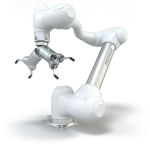Working across the supply chain
Industry 4.0 is changing the way we work across the supply chain. Using AI, sensors, and Internet of Things (IoT) technology, a smart and data-driven distribution center can be developed. For example, by cross-referencing enterprise resource planning (ERP) systems with consumer trends data, AI technology can automatically order the correct amount of raw materials to fulfil orders, reducing waste and increasing profit. As the complex web of distribution is opened to the benefits of AI, the supply chain could have a bigger economic benefit than any other application of AI in manufacturing. Using this technology, distributors will no longer need to predict demand for products through guesswork but will instead merge datasets to make accurate predictions about the future, enabling them to make well-informed business decisions. Inventory level efficiency With insight into future demand, AI can also help with forecasting the demand of your suppliers, based on previous orders. This means crucial decisions can be made to optimize stock levels. For example, if your AI software lets a distributor know that many other distributors will want the same equipment in 12 months’ time, you would be sure to jump the queue and get ahead by ordering it much sooner than this. Cost of goods sold Why does it matter if inventory levels aren’t optimised? Well, it’s related to inventory level efficiency. Your cost of goods sold (COGS) will reduce since you don’t incur costs of holding inventory beyond its use. In 2015, the cost of over-stocking was $470 billion, and of under-stocking was $630 billion worldwide, according to IHL Group. Freeing up cash and storage space creates the potential for savings. Lead times As Industry 4.0 empowers your supply chain to manage different orders faster, lead times for customers will shorten. However, this increases the pressure to deliver on time, […]









